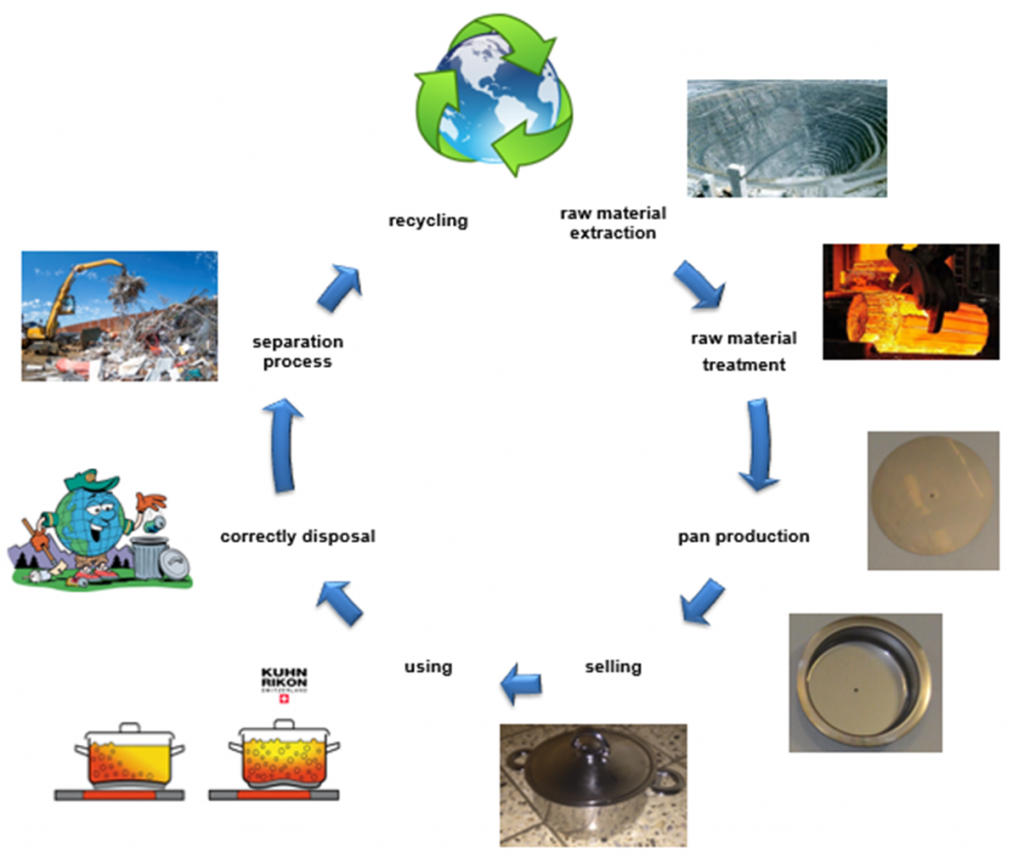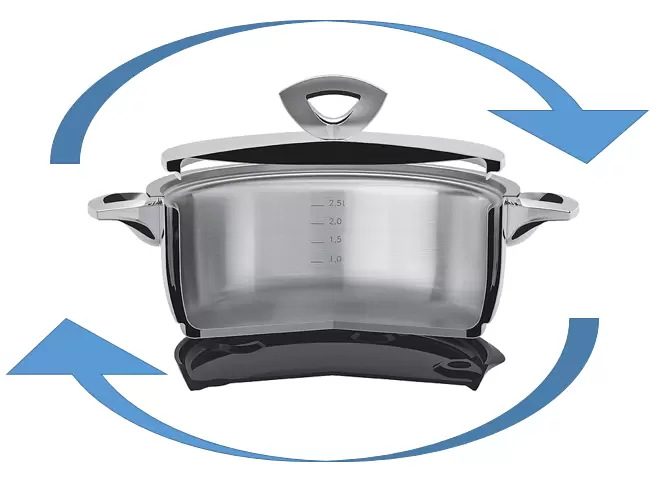We have chosen a typical every day product. Our focus is on the production and recycling process of pans. We are interested to know more about the toxic components and what kind of effect they have on the environment. We have conducted two interviews, one with Kuhn Rikon AG, a pan production company and another with a member of a disposal center based in Bäretswil. All used information comes from these two interviews.
The product lifecycle will be split in the following parts:

Extraction and processing of raw material
The metals that are used for pan productions can be mined all over the world. However, the main mining occurs in China with 58 % (Status: 2011). Also, China is the biggest processor of metal with 32 %. It has the lead in market according to the 20 biggest steel producers (Status: 2015). This was unimaginable 25 years ago, because back then the country had just one producer in the Top 20 list.
Pan production
The producer:
Our main focus lied on the production side of pans. We had an excellent information source with the company Kuhn Rikon AG which is based in the countryside of Zurich.
During our interview and the tour through the production center we could find out the following points:
- Today, the company of Kuhn Rikon AG is the only remaining producer of kitchenware in Switzerland and has a company history of more than 90 years.
- The production takes place in two work shifts. Starting at five o’clock in the morning and ending at ten o’clock in the evening. In this working area are already 50 persons employed.
Product division and environmental aspects:
The company offers two seperate product lines.
Swiss Made:
The products with this label were developed and manufactured in Switzerland.
Swiss Design:
The developement and research of all products under this label take place in Switzerland, but the production will be done from a different manufacturer in another country.
The company has to comply with the seal of quality Swiss Made, as well with many customary and regional policies. Their goal is that everybody will work with the resources considerately. They take extra care to ensure environmentally friendly production of kitchenware, accessories and packaging. Recycling is also an important aspect.
The company has high-quality standards by selectively choosing their suppliers. However, the environmental aspect is not crucial when selecting the third-party manufacturers.
How you make a pan out of a steel plate:
All materials, which are used for the manufacturing process of a pan are non-toxic for humans, furthermore there is no danger by using the pan after the perforation of the surface has woren off the pan.
The round steel plate will be formed in the shape of a pan, because of the deep-drawing process. In an additional step the homemade «Sandwichbase» will be soldered as well as the magnetic plate will be fixated. This is required that the heating with the induction cooker will be secured. After several times of grinding, polishing and quality controls, the final step will be the engraving with the support of a laser. The handles will then be attached and after the packing process, the pan is ready for the delivery.
It takes one week to produce a pan. The reason is that the production has to take place in single steps. A floating production is not useful, because of the dangers that the whole production would have to shut down due to a partial error.
Energy consumption:
The energy consumption per pan applies to 7.7 kW (incl. infrastructure and office). In comparison to a car with combustion engine you could drive almost 13 km.
Calculation basis: Average energy consumption of six liters of fuel or rather 60 kWh per 100 km.
Wikipedia article: Watt-hours
The Oil consumption per pan applies to 0.52 liters (only for heating the building). In comparison you could heat a 40 m2 flat for a half an hour.
Calculation basis: (15 liters per m2 per year)
K-Tipp article: Heating costs
The water consumption per pan applies to 0.051 liters (incl. infrastructure and office)
If you are interested in the detailed process of the production of a pan, do not hesitate to consult the following film: Kuhn Rikon AG – production film
Environmentally friendly use:
Kuhn Rikon AG offers electricity-reducing technology that uses more heat efficiently, because of the « Sandwich base » which they developed themselves.

Correctly disposal
Company internal recycling concept:
Kuhn Rikon AG offers a repair service, which is a cost–effective and ecologically friendly alternative, because the product must not be replaced.
If the pan is only lightly damaged, then the customer can leave the product directly at the service desk. They will take the pan components apart and will give the left-over materials to a scrap dealer to recycle. The scrap dealer will utilize the materials and implement them in the raw material cycle.
Conventional recycling
Pans should be collected like every other metal item in a metal pit. This pit will hold max. 30 m3 and comply ca. 235 tons concentrated materials. A filled pit will hold 3.5 tons in average, because of the airspace. The employees of the collection center will pick out the items which are not made out of metal. An example is the plastic handle of a pan.
The pit will be sold to a metal processor, which will separate the different type of metals and the fine screening will be done by the specific weight of the metal. At the end, he will sell the different metals to the highest bidding customer for the recycling. In Switzerland there is only one big company called Von Roll, which still recycles metals. The main reason are the high costs of energy in our country.
In contrast to the other materials, for example paper, has metal no loss of quality when you recycle it. Another reason is also that you can separate the different metals very easily.
During our interview at the collection center in Bäretswil we found out, that China is the biggest bulk buyer of metal. Since Chinas market entry 10 years ago, you can see a big price increase of metal. Due to price fluctuations many people bring their metal scraps directly to the metal utilizer to dispose.
Sources:
All used information is based on two interviews, one with Kuhn Rikon AG, a pan production company and another with a member of a disposal center based in Bäretswil.
Image-links:
- Promo pan picture
- Raw material extraction
- Raw material Treatment
- Kuhn Rikon AG – Sandwich base
- Correctly disposal
- Separation process
- Recycling
posted by Michael Widrig & Daniel Kläy
☷ See the project teams here »
☵ Some words about the contributions »
☴ Our sponsors and partners » (the-horse.education)

Goodmorning,
My name is Paula Fonseca Flores and I am looking for data to make a theoretical model of a stainless steel pan. I am writting my Master Thesis in the TU Berlin based on a LCA of a stainless steel pan to explore the challenges and opportunities to incorporate Remanufacturing in LCA. Any shared information about your LCA can be highly valuable and I would cite your finding accordingly. Also if you can share with me data, it would improve the accuracy of the study.
Thank you very much in advance!
Kind regards,
Paula Fonseca Flores
Dear Paula,
Thanks for reaching out! I’d recommend getting in touch directly with Kuhn Rikon, as they focus a lot on sustainability and CO₂ assessments. You can find interesting Infos on their website: https://kuhnrikon.com/ch_de/ueber-uns/nachhaltigkeit/co2-fussabdruck
Hope this helps, and best of luck with your thesis about LCA, a crucial topic, indeed!
Best,
Eliane
Hallo Michael und Daniel
Herzlichen Dank und Gratulation zur tollen Arbeit.
Wünsche weiterhin viel Erfolg bei Eurer Ausbildung.
Gruss Heinz Allenspach
Kuhn Rikon AG
Guten Tag Herr Allenspach
Wir danken Ihnen vielmals für Ihre Beurteilung und wünschen Ihnen einen schönen Tag.
Freundliche Grüsse
Michael & Daniel
Dear Team W2W49
We can see that you invested a lot of time in your project and it absolutely pays off.
Your product lifecycle is brilliant and got us a nice overview.
The environmental aspects were also very intersting to us.
Greetings Ben & Dave
Hey Team w2w49
Your article is amazing because we feel how much engagement you\’ve invested. Further, it\’s very interesting. As you said, we use pans everyday but we never knew something about it before. In our opinion, the recycling concept from Kuhn Rikon is great for our environment. In the future, we\’ll buy only good quality pans from Kuhn Rikon.
Gillian and Mara